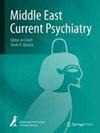Prevalence of sleep disturbances and its relationship with mobile phone overuse among an Iranian sample of students: a necessity for attention
IF 1.6
Q3 PSYCHIATRY
引用次数: 0
Abstract
Abstract Background and objectives Sleep disturbances are recognized as a potential core feature of some major psychiatric conditions, and overuse of mobile phones in recent years can leave potential negative effects on this central feature, which is especially important to assess among students. Our study aimed to investigate the prevalence of sleep disturbances and its relationship with mobile phone overuse among an Iranian sample of university students. Methods After 406 Iranian students from the Birjand University of Medical Sciences completed the demographic data, Mobile Phone Problematic Use Scale (MPPUS), and Pittsburgh Sleep Quality Index (PSQI) questionnaires, data were analyzed using independent t -test, analysis of variance, and Pearson correlation coefficient. Results 74.4% of individuals had a moderate to severe problem with their subjective sleep quality, and 33.7% had moderate to severe problems with delay in falling asleep. Additionally, 44.1% of individuals experienced mild to moderate problems in sleep duration, and most of them (97.3%) severely suffered from inadequate sleep efficiency. In terms of sleep disorders, 78.8% of individuals reported a mild problem. Furthermore, most individuals (81.3%) have not used sleep-inducing medications to fall asleep, and in terms of daily dysfunction, 75.57% individuals had mild to moderate problems. Additionally, a significant positive correlation of 0.244 was observed between the score of sleep disturbances and mobile phone overuse ( P < 0.05). Conclusions The prevalence of sleep disturbances was quite considerable, and there was a significant positive relationship between excessive mobile phone use and sleep disturbances among the target group.伊朗学生样本中睡眠障碍的普遍性及其与手机过度使用的关系:需要引起注意
背景与目的睡眠障碍被认为是一些主要精神疾病的潜在核心特征,而近年来过度使用手机可能会对这一核心特征产生潜在的负面影响,对学生进行评估尤为重要。我们的研究旨在调查伊朗大学生样本中睡眠障碍的患病率及其与手机过度使用的关系。方法对406名来自Birjand医科大学的伊朗留学生填写人口统计资料、手机问题使用量表(MPPUS)和匹兹堡睡眠质量指数(PSQI)问卷,采用独立t检验、方差分析和Pearson相关系数对数据进行分析。结果74.4%的人主观睡眠质量存在中重度问题,33.7%的人主观睡眠质量存在中重度延迟入睡问题。此外,44.1%的人在睡眠时间上有轻度到中度的问题,其中大多数人(97.3%)严重缺乏睡眠效率。在睡眠障碍方面,78.8%的人报告有轻微的问题。此外,大多数人(81.3%)没有使用安眠药入睡,在日常功能障碍方面,75.57%的人有轻度到中度的问题。此外,睡眠障碍得分与手机过度使用之间存在显著的正相关(P <0.05)。结论目标人群睡眠障碍患病率相当高,过度使用手机与睡眠障碍之间存在显著正相关关系。
本文章由计算机程序翻译,如有差异,请以英文原文为准。
求助全文
约1分钟内获得全文
求助全文
来源期刊

Middle East Current Psychiatry
Medicine-Psychiatry and Mental Health
CiteScore
3.00
自引率
0.00%
发文量
89
审稿时长
9 weeks
 求助内容:
求助内容: 应助结果提醒方式:
应助结果提醒方式:


